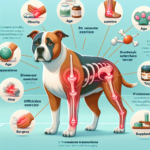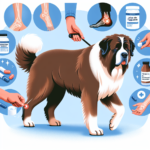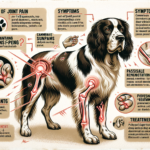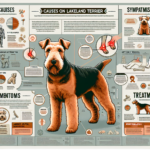Small Munsterlander Joint Pain: Causes, Symptoms, Prevention, and Treatment
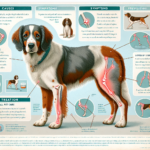
Introduction
The Small Munsterlander is a versatile hunting dog breed that originated in Germany. Known for their intelligence, agility, and keen sense of smell, these dogs have been used for hunting and retrieving game for centuries. They are medium-sized dogs with a well-balanced build, characterized by their expressive eyes and distinctive coat patterns. Despite their robust nature, Small Munsterlanders are prone to certain health issues, with joint pain being a significant concern.
Joint health is crucial for the Small Munsterlander, given their active lifestyle and the physical demands of their typical activities. Joint pain can severely impact their quality of life, making it essential for owners to be aware of the causes, symptoms, preventive measures, and treatment options available for managing this condition.
Breed-Specific Joint Pain Risks
Genetic Predisposition
Small Munsterlanders, like many other breeds, are genetically predisposed to certain joint-related issues. Hip dysplasia, a condition where the hip joint doesn’t fit properly into the hip socket, is relatively common in this breed. Elbow dysplasia, where the elbow joint is malformed, can also occur. Both conditions can lead to arthritis and chronic pain if not addressed early.
Age-Related Risks
As Small Munsterlanders age, the risk of developing joint pain increases. The cartilage that cushions the joints can wear down over time, leading to osteoarthritis. Owners should be particularly vigilant as their dogs approach middle age, typically around 5-7 years, as this is when joint issues often start to manifest.
Activity Level and Joint Stress
Small Munsterlanders are highly active dogs, often used in hunting and sporting activities. While their activity level is beneficial for their overall health, it can also contribute to joint stress. Repetitive motions, high-impact activities, and strenuous exercise can exacerbate joint issues, making it essential to balance their activity levels with adequate rest and recovery.
Common Symptoms of Joint Pain in Small Munsterlanders
General Symptoms
- Limping or favoring one leg
- Stiffness, especially after rest
- Reluctance to jump, run, or climb stairs
- Decreased activity or playfulness
- Swelling around the joints
- Whining or showing signs of discomfort when touched
Breed-Specific Symptoms
In Small Munsterlanders, joint pain may also manifest as a reluctance to engage in hunting or retrieving activities, which are typically their favorite pastimes. Owners might notice a decrease in their dog’s enthusiasm for these activities, which can be a subtle but telling sign of joint discomfort.
When to Consult a Vet
If you observe any of the above symptoms in your Small Munsterlander, it’s crucial to consult a veterinarian promptly. Early diagnosis and intervention can significantly improve the prognosis and quality of life for your dog. Persistent limping, noticeable pain, or any sudden changes in behavior should be addressed immediately.
Preventive Measures for Joint Health
Exercise Recommendations
Regular, moderate exercise is essential for maintaining joint health in Small Munsterlanders. Activities like swimming, which is low-impact, can be particularly beneficial. Avoid high-impact exercises like excessive running on hard surfaces. Instead, opt for varied activities that keep your dog active without overloading their joints.
Dietary Suggestions
A balanced diet rich in essential nutrients can support joint health. Look for dog foods that contain glucosamine and chondroitin, which help maintain cartilage health. Omega-3 fatty acids, found in fish oil supplements, can also reduce inflammation and support joint function. Always consult your vet before adding supplements to your dog’s diet.
Weight Management
Maintaining a healthy weight is crucial for reducing joint stress. Overweight dogs are at a higher risk of developing joint issues due to the extra load on their joints. Regularly monitor your dog’s weight and adjust their diet and exercise routine as needed to keep them within a healthy weight range.
Early Screening and Monitoring
Regular veterinary check-ups are essential for early detection of joint issues. Screening tests like X-rays can help identify problems before they become severe. For breeds like the Small Munsterlander, early screening for hip and elbow dysplasia is particularly important.
Treatment Options for Joint Pain
Non-Surgical Treatments
Non-surgical treatments for joint pain include medications like non-steroidal anti-inflammatory drugs (NSAIDs) to reduce pain and inflammation. Physical therapy can also be beneficial, helping to strengthen the muscles around the joints and improve mobility. Lifestyle adjustments, such as modifying exercise routines and providing a comfortable resting area, can also make a significant difference.
Surgical Options
In severe cases, surgical intervention may be necessary. Procedures like hip replacement or arthroscopy can provide significant relief and improve joint function. The type of surgery will depend on the specific joint issue and the overall health of the dog. Always consult with a veterinary specialist to determine the best course of action.
Alternative Therapies
Alternative treatments like acupuncture, hydrotherapy, and massage can also be effective in managing joint pain. These therapies can help reduce pain, improve circulation, and enhance overall well-being. Consult with a veterinarian experienced in alternative therapies to explore these options.
Lifestyle and Management Tips
Daily Care Routine
A consistent daily care routine can help manage joint pain in Small Munsterlanders. This might include gentle morning exercises, a balanced diet with joint supplements, and regular rest periods. Monitoring your dog’s behavior and adjusting activities based on their comfort level is key.
Modifying the Home Environment
Making your home more comfortable for a dog with joint pain can significantly improve their quality of life. Consider adding ramps to help them navigate stairs, providing orthopedic beds for better joint support, and ensuring their living area is free of obstacles that could cause injury.
Long-Term Management
Long-term management of joint pain involves regular veterinary check-ups, ongoing weight management, and a balanced exercise routine. Keeping your dog active and engaged, while avoiding activities that strain their joints, is essential for their long-term well-being.
FAQs About Small Munsterlanders and Joint Pain
What are the early signs of joint pain in Small Munsterlanders?
Early signs include limping, stiffness, reluctance to move, and decreased activity levels. If you notice any of these symptoms, consult your vet for a thorough examination.
Can joint pain in Small Munsterlanders be prevented?
While genetic predispositions can’t be entirely prevented, maintaining a healthy weight, providing a balanced diet, and ensuring regular, moderate exercise can significantly reduce the risk of joint pain.
Are there specific foods that can help with joint health?
Yes, foods rich in glucosamine, chondroitin, and omega-3 fatty acids can support joint health. Consult your vet for dietary recommendations tailored to your dog’s needs.
When should I consider surgery for my dog’s joint pain?
Surgery is usually considered when non-surgical treatments fail to provide relief, and the dog’s quality of life is significantly impacted. Consult with a veterinary specialist to explore surgical options.
Conclusion
Joint pain is a significant concern for Small Munsterlanders, given their active lifestyle and genetic predispositions. By understanding the causes, symptoms, preventive measures, and treatment options, owners can take proactive steps to ensure their dog’s joint health. Regular veterinary check-ups, a balanced diet, appropriate exercise, and weight management are crucial for preventing and managing joint pain. Always consult your veterinarian for personalized advice and treatment plans to keep your Small Munsterlander happy and healthy.

